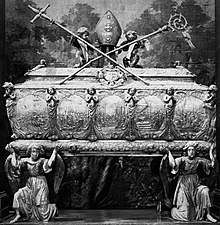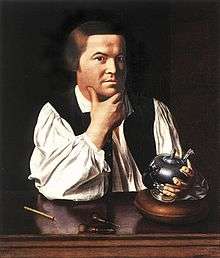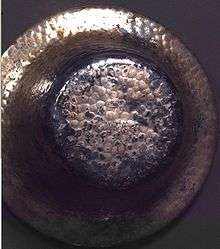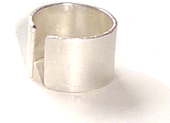Silversmith
A silversmith is a metalworker who crafts objects from silver. The terms silversmith and goldsmith are not exactly synonyms as the techniques, training, history, and guilds are or were largely the same but the end product may vary greatly as may the scale of objects created.

History

In the ancient Near East the value of silver to gold being less, allowed a silversmith to produce objects and store these as stock. Ogden states that according to an edict written by Diocletian in 301 A.D., a silversmith was able to charge 75, 100, 150, 200, 250, or 300 denarii for material produce (per Roman pound). At that time, guilds of silversmiths formed to arbitrate disputes, protect its members' welfare and educate the public of the trade.[2]
Silversmiths in medieval Europe and England formed guilds and transmitted their tools and techniques to new generations via the apprentice tradition. Silver working guilds often maintained consistency and upheld standards at the expense of innovation. Beginning in the 17th century, artisans emigrated to America and experienced fewer restrictions. As a result, silver working was one of the trades that helped to inaugurate the technological and industrial history of the United States silver-working shift to industrialization.
Very exquisite and distinctly designed silverware, that goes by the name of Swami Silver, emerged from the stable of watchmaker turned silversmith P Orr and Sons in the South Indian city of Madras (now Chennai) during the British rule in 1875.
The Beta Israel known more widely as the Falasha of Ethiopia were known for their silversmithing skills.
Tools, materials and techniques

- saw (jeweler's saw)
- snips
- flat file
- jewelers' files
- planishing hammer
- raising hammer
- cross-pein hammer
- ball-pein hammer
- anvils
- stakes
- swage blocks
- riveting
- silver hard-solder
- flux
- torch or blow-pipe
- pickle (Dilute sulphuric acid or organic acids which are used to remove firescale[3])
- buffing wheels
- polishing compounds.
- chasing
- repoussé
- engraving
Silversmiths saw or cut specific shapes from sterling and fine silver sheet metal and bar stock, and then use hammers to form the metal over anvils and stakes. Silver is hammered cold (at room temperature). As the metal is hammered, bent, and worked, it 'work-hardens'. Annealing is the heat-treatment used to make the metal soft again. If metal is work-hardened, and not annealed occasionally, the metal will crack and weaken the work.
Silversmiths can use casting techniques to create knobs, handles and feet for the hollowware they are making.
After forming and casting, the various pieces may be assembled by soldering and riveting.
During most of their history, silversmiths used charcoal or coke fired forges, and lung-powered blow-pipes for soldering and annealing. Modern silversmiths commonly use gas burning torches as heat sources. A newer method is laser beam welding.
Silversmiths may also work with copper and brass, especially when making practice pieces, due to those materials having similar working properties and being more affordable than silver.
Related and overlapping trades

Although jewelers also work in silver and gold, and many of the techniques for working precious metals overlap, the trades of jeweler and Silversmith have distinct histories. Chain-making and gem-setting are common practices of jewelers that are not usually considered aspects of silversmiths.
The tradition of making (iron / plate) armor was interrupted sometime after the 17th century. Silversmithing and goldsmithing, by contrast, have an unbroken tradition going back many millennia. The techniques used to make armor today (whether for movies or for historical recreation groups) are an amalgam of silversmith forming techniques and blacksmith iron-handling techniques.
Notable and historical silversmiths
- Companies
- People
- Acragas
- Kurt Aepli
- Hester Bateman
- Jocelyn Burton
- Benvenuto Cellini
- Stephen Emery, early American silversmith
- Thomas Germain
- François-Thomas Germain
- Isaac Hutton
- Georg Jensen
- Sampson Mordan
- Jean-Valentin Morel, French jeweler and craftsman
- Henry Petzal
- Paul Revere, American silversmith, manufacturer, and patriot
- Atsidi Sani (Old Smith in English), the first known Navajo silversmith
- Alfredo Sciarrotta
- Sequoyah, Cherokee silversmith, inventor of the Cherokee syllabary
- Alice Sheene
- Robert Welch
- Edward Winlsow Early American silversmith
* Garrad & Co. was founded by George Wickes in London in 1722 and is still operating.
** Reid & Sons was founded in 1788 in Newcastle and is still operating
See also
References
- Marcin Latka. "Silver sarcophagus of Saint Stanislaus". artinpl. Retrieved 3 August 2019.
- Jack Ogden (1992). Ancient Jewelry. University of California Press. Retrieved 10 April 2012.
- Brain, Charles. "Pickling Notes". The Ganoksin Project. Retrieved 15 June 2013.
External links
| Wikimedia Commons has media related to Silversmiths. |
- Society of American Silversmiths
- Jeff Herman's comprehensive guide for professional silver care methods and products
- Staatliche Zeichenakademie Hanau (Silversmith)
- Stamped silver button, made 1787 image from Victoria & Albert Museum jewellery collection.
- Gee,G. The silversmith's handbook : containing full instructions for the alloying and working of silver, including the different modes of refining and melting the metal; its solders; the preparation of imitation alloys...(1921.)
- Wilson,H. Silverwork and jewelry : a text-book for students and workers in metal ( 1912.)
- Sampson Mordan